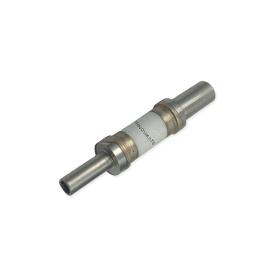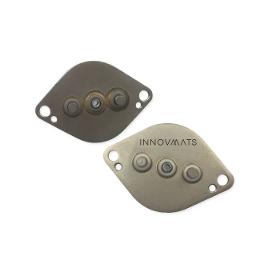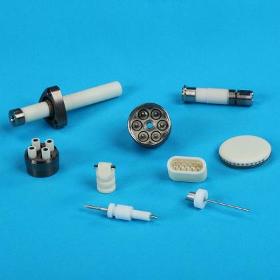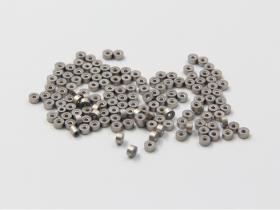- europages
- >
- COMPANIES - SUPPLIERS - SERVICE PROVIDERS
- >
- ceramic-metal feedthroughs
Results for
Ceramic-metal feedthroughs - Import export

XIAMEN INNOVACERA ADVANCED MATERIALS CO., LTD
China
Ceramic-to-Metal Seal The Ceramic Surfaces for Brazing, the surface must be metallized. Compare to Glass seal, Ceramic seal has exceptional resistance to thermal and mechanical shock as well as corrosion. While it requires more complex manufacturing processes and sophisticated engineering, the price is obviously higher.
Request for a quote
XIAMEN INNOVACERA ADVANCED MATERIALS CO., LTD
China
Mo Mn Ceramic Feedthrough Ceramic Vacuum Electrodes The Ceramic Surfaces for Brazing, the surface must be metallized. Compare to Glass seal, Ceramic seal has exceptional resistance to thermal and mechanical shock as well as corrosion. While it requires more complex manufacturing processes and sophisticated engineering, the price is obviously higher. Advantages of Ceramic-to-Metal Seals * More solid, durable hermetic seal and better electrical insulation * Used for more harsh conditions, such as high and low (cryogenic) temperature, corrosive, high pressure, and high vacuum environments * High mechanical strength, less fracture when applied to high vibration and high g-load conditions * Shows strong bond and an excellent seal with metals and alloys, such as copper and Cu alloys (CuNi) and to nickel and Ni alloys.
Request for a quote
MICROCERTEC
France
Microcertec has established a partnership with PNL INNOTECH, a french company specialized in glass-sealed hermetic connectors, as well as ceramic-metal and metal-metal brazed components. These products are dedicated to demanding high technological industries, such as: Defence Aerospace Physics Accelerators (Synchrotron, Tokamak, Collider...) Oil Medical Nuclear Environment Principle PNL INNOTECH components are designed to meet harsh environment requirements and product applications, from prototype to large quantities: Glass-sealed and ceramic-metal brazed hermetic connectors (Kovar, S/S, Molybdenum, Inconel, Titanium ...) Ceramic-metal custom built feedthroughs for high current or voltage Microelectronic package and heatsink U.H.V viewports ( Sapphire, Quartz, CaF2, BaF2, Ge, ZnSe ...) Market range, i.e : Microelectronic Microwaves U.H.V components Cryogenics Non-magnetic requirements High pressure Signal feedthroughs Equipment Manufacturing processes are carried out in high...
Request for a quote
XIAMEN INNOVACERA ADVANCED MATERIALS CO., LTD
China
Innovacera supplies precision metallized ceramic components in aluminum oxide ceramics for the military, medical, and aerospace industries. Through spray, needle, and brush coatings or screen printing our capabilities allow us to metallized on flat, cylindrical, and complex ceramic bodies. Moly-Manganese is the typical base coat materials used for metallization.
Request for a quote
XIAMEN INNOVACERA ADVANCED MATERIALS CO., LTD
China
In a development that could have a significant impact on the electronics industry, the latest ceramic metallized insulators are making strides in enhancing semiconductor packaging and related applications. These insulators offer a range of practical benefits that can improve the performance and durability of electronic components. Let’s take a closer look at what sets them apart: Key Features of Ceramic Metallized Insulators: 1. Stability and Strength: The ceramic material employed in these insulators boasts an even texture, ensuring every batch maintains stable quality and flexural strength. This consistency in material quality is pivotal for the reliability of electronic components. 2.Dense and Weldable Metal Layer: The metal layers in these insulators are densely applied, providing a smooth and even surface. This not only enhances their appearance but also makes them easy to work with, particularly in manufacturing processes.
Request for a quoteDo you sell or make similar products?
Sign up to europages and have your products listed

XIAMEN INNOVACERA ADVANCED MATERIALS CO., LTD
China
DBC ceramic substrate: Direct bonded copper (DBC) substrates are commonly used in power modules, because of their very good thermal conductivity. They are composed of a ceramic tile (commonly alumina) with a sheet of copper bonded to one or both sides by a high-temperature oxidation process (the copper and substrate are heated to a carefully controlled temperature in an atmosphere of nitrogen containing about 30 ppm of oxygen; under these conditions, a copper-oxygen eutectic forms which bonds successfully both to copper and the oxides used as substrates). The top copper layer can be preformed prior to firing or chemically etched using printed circuit board technology to form an electrical circuit, while the bottom copper layer is usually kept plain. The substrate is attached to a heat spreader by soldering the bottom copper layer to it. 1. Thickness of substrate can be thin: 0.25mm,0.28mm,0.45mm,0.5mm,0.635mm,1.0mm,1.5mm, 1.8mm,2.0mm 2.
Request for a quote
XIAMEN INNOVACERA ADVANCED MATERIALS CO., LTD
China
High Hermeticity Metallized Ceramic Bushing /Innovacera Features: 1.Material: 96% Aluminia(AL2O3) 2.Coating Layer:Molybdenum-Mananese(Mo/Mn) 3.These metallized ceramics are ideal for high voltage, high vacuum and high pressure applicationos. So far the most widely-used and effective method for creating a leak-tight, robust joint between ceramic and metal is by brazing . A thin layer of metal deposited on a ceramic part enables brazing between ceramic and metal part that h as a different coefficient of thermal expansion. A layer of Molybdenum-Manganese is deposited with a typical thickness of 8 to 30 µm after sintering. The metallized surface receives a secondary coating of nickel to seal and improve wettability for later brazing.
Request for a quote
XIAMEN INNOVACERA ADVANCED MATERIALS CO., LTD
China
Metallized Ceramic Componenets: Innovacera supplies precision metallized ceramic parts in aluminum oxide ceramics for the medical, and aerospace industries. Through spray, needle, and brush coatings or screen printing our capabilities allow us to metallized on flat, cylindrical, and complex ceramic bodies. Moly-Manganese is the typical base coat materials used for metallization.In order to achieve the welding between ceramic and metal, the ceramic surface firmly adheres to a layer of the metal film, which is ceramic metallization.Refractory-metalized aluminum oxide ceramics widely use in power grid tubes, vacuum interrupters, and similar applications where metal to ceramic joints of exceptional strength and hermeticity is required. Specification >Metallization thickness: 25 ±10um >Nickel thickness:2~10um >Pin full strength: 4200kgf/cm2 avg. (at Φ3.0mm pin) Available Ceramic Composition >94%,96%,99%,99.
Request for a quote
XIAMEN INNOVACERA ADVANCED MATERIALS CO., LTD
China
Metallized Ceramic Componenets: Innovacera supplies precision metallized ceramic ring in aluminum oxide ceramics for the military,medical, and aerospace industries. Through spray, needle, and brush coatings or screen printing our capabilities allow us to metallized on flat, cylindrical, and complex ceramic bodies. Moly-Manganese is the typical base coat materials used for metallization.In order to achieve the welding between ceramic and metal, the ceramic surface firmly adheres to a layer of the metal film, which is ceramic metallization. Refractory-metalized aluminum oxide ceramics widely use in power grid tubes, vacuum interrupters, and similar applications where metal to ceramic joints of exceptional strength and hermeticity is required.
Request for a quote
UDEN-UKRAINE
Ukraine
(UDEN-S wall heaters are an excellent choice for autonomous or additional heating of any standard premises: apartments, houses, budgetary institutions or commercial real estate): ○ Metal-ceramic design heater UDEN-1000 (Energy-efficient metal-ceramic heaters UDEN-S are used to heat a variety of rooms: apartments, private homes, commercial real estate, and social spheres)
Request for a quoteResults for
Ceramic-metal feedthroughs - Import exportNumber of results
11 ProductsCountries
Company type